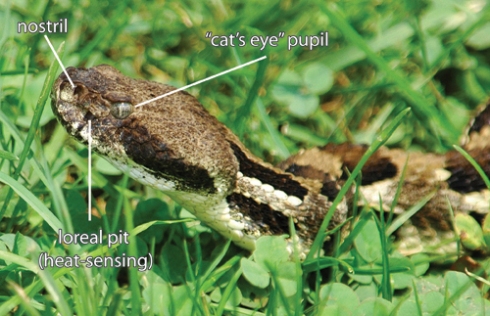Snakes might not be out there penning beautiful odes or solving quadratic equations (although they have the intelligence necessary to hunt clever birds and mammals) however the reptiles are distinguished by their amazing sensory abilities. Like the extraordinary siluriformes (the catfish, which are living tongues that apprehend the world in astonishing ways), certain snakes have abilities to perceive things which other animals simply cannot detect.
Snakes double the primary senses of hearing, smelling, and sight—which means that some snakes effectively have eight or more senses. Let’s go through these senses individually.
Hearing: Although the reptiles lack external ears, they have sensitive inner ears which allow them to hear airborne vibrations. This however is only one mechanism of hearing for snakes: the animals have jaws linked to their inner ears which allow them to hear extremely faint vibrations. Since most serpents have lower jawbones which are separated into two distinct bones, the animals are extremely adept at locating the source of a sound from the different time/frequency that vibrations strike the different bones. This means they can hear the source of sound with pinpoint accuracy. These hearing abilities give some snakes 9especially desert snakes) the ability to hunt by sound in absolute darkness.
Smell/taste: Snakes breathe through two nostrils, but unlike mammals their “noses” have little to do with their sense of smell. To quote an article involving snake senses from reptilis.net:
…snakes have gone a different route, one taken by their lepidosaurian relatives a long time ago. Instead of using only their nose, snakes have adapted their tongue and sense of taste to capturing scent particles in the air and transforming it into olfactory information.
Better yet, because snakes “smell” by “tasting” the air with their tongues, and because those tongues are typically forked, they also have incredible directional smelling. Snakes effectively smell in stereo.
So snakes are capable of amazing abilities to taste/smell their environment and they have directional smell which almost acts like hearing or sight in locating prey or mates.
Sight: Most snakes have conventional binocular optical abilities on par with other vertebrates (although tree snakes are known to have particularly fine vision) however many groups of snakes (particularly the python and viper families) possess astonishing heat-sensing pit organs that can detect infrared light. For their size, the sense organs are more heat sensitive than anything humans have created with technology.
Touch: Snakes have an amazingly sophisticated sense of touch (as one would might imagine for an animal which lives on its belly). Thanks to their sense of touch they can respond immediately to stimuli from their environment and they can feel the slightest changes in their habitat. Additionally touch is important for snakes socially and is a primary means of communication between snakes of the same species.
As with sharks, cats, and owls, snakes have used their astonishing senses to become formidable predators. Snakes are widespread in all of the continents other than Antarctica and they dwell in all habitats other than permanently cold ones and deep ocean (well, plus a couple of weird islands). This success is a result of their sharp and numerous senses.






4 comments
Comments feed for this article
February 15, 2013 at 7:38 PM
Bill
Did you see this?
February 15, 2013 at 8:25 PM
Wayne
Hi Bill. See what now?
February 16, 2013 at 12:22 PM
Wayne
Did you write something in the infrared spectrum?
May 4, 2019 at 3:19 AM
Anonymous
Very helpful for my son